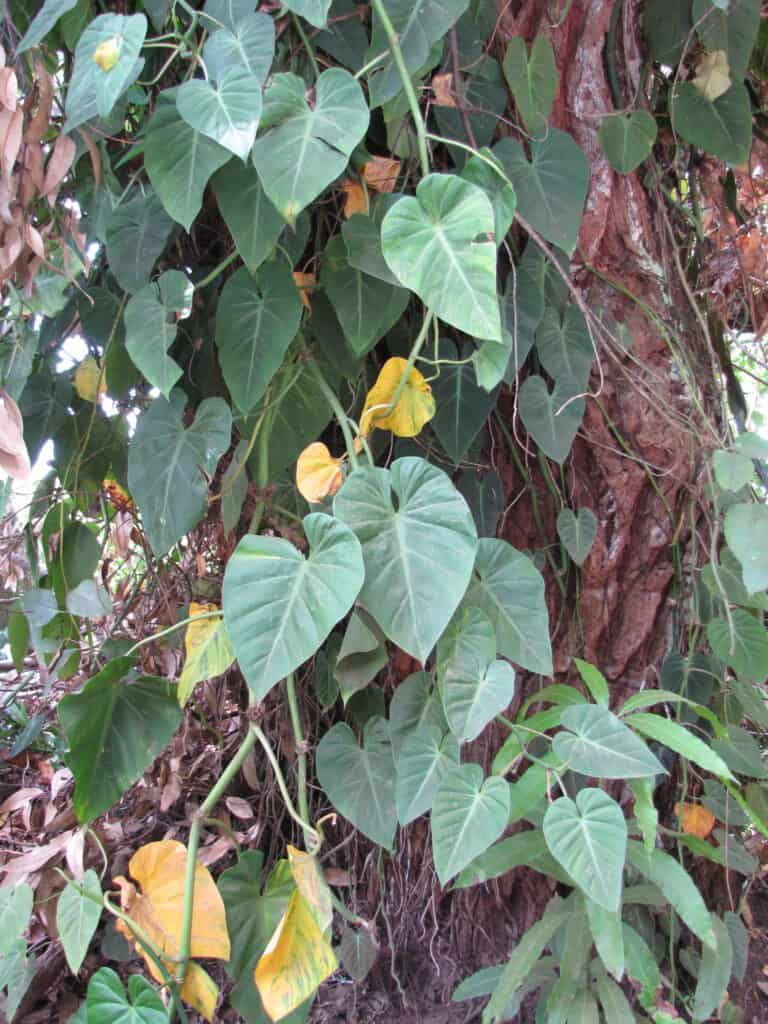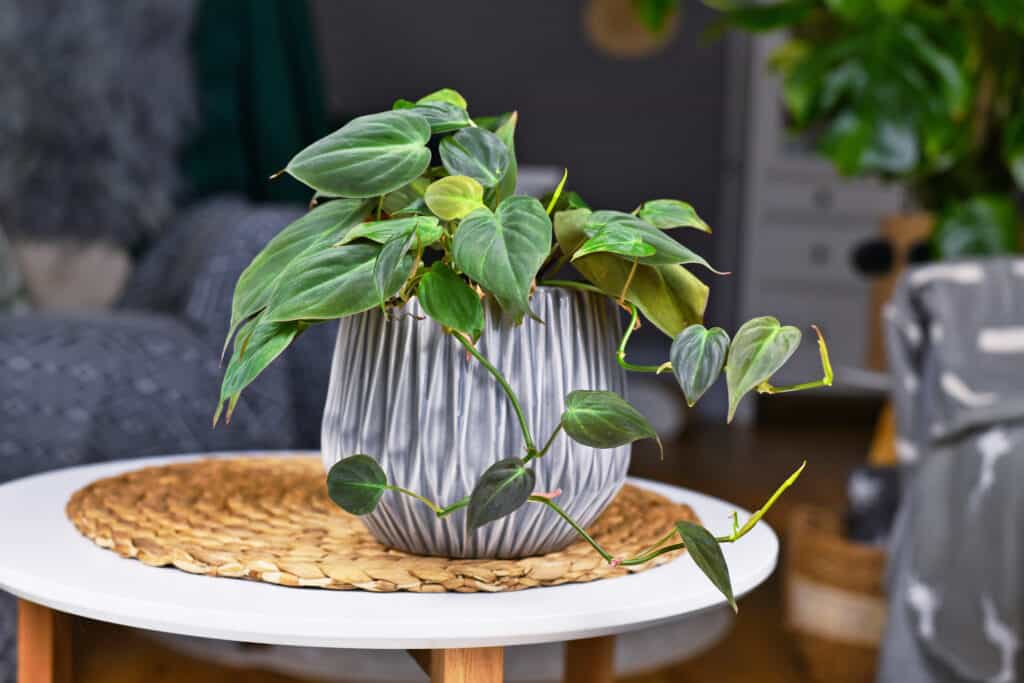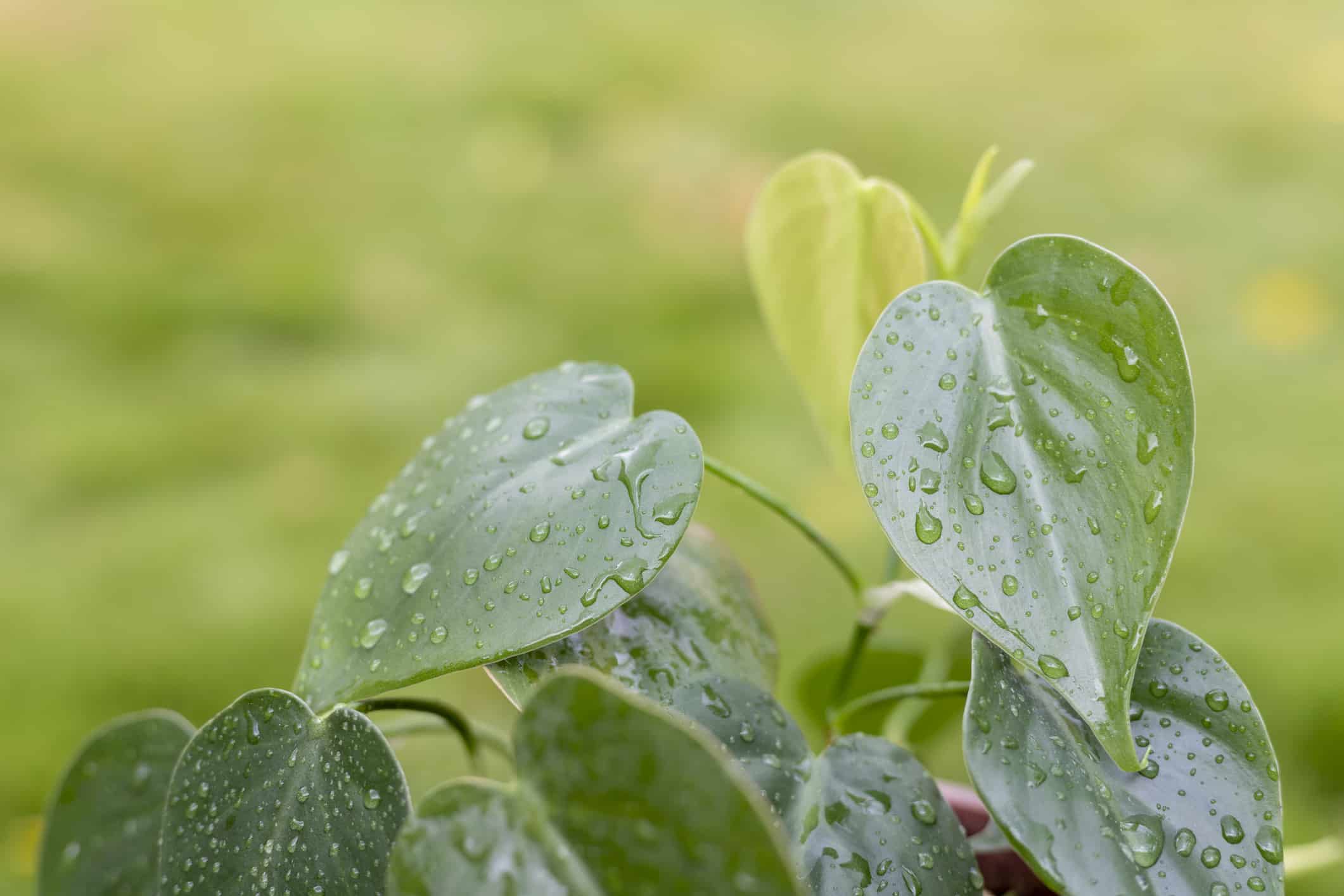Philodendrons are lovely leafy houseplants that oxygenate your living areas and bring that necessary touch of the great outdoors to soothe your nerves. There are many species of “philos” as they’re often called, but Philodendron Cordatum vs. Heartleaf are two of the most attractive. Let’s take a closer look to see how they’re different.
Key Differences Between Philodendron Cordatum vs. Heartleaf
The key differences between these two plants lie in the foliage. Cordatum has lighter green leaves with faint veining that mature to green-gray whereas Heartleaf has darker green foliage that emerges green-bronze.
They are also from different areas. Heartleaf philodendron is from Central America and Cordatum is from South America, Southeastern Brazil to be exact.
The problems identifying them occur because Cordatum philodendron is a type of heartleaf philodendron too!
| Name | Philodendron Cordatum | Heartleaf Philodendron (Philodendron hederaceum, Philodendron scandens) |
| Origins | South America | Central America |
| Foliage | Lighter green with less visible veins. Gray-green as the plant ages | Dark green, bronze new growth |
| Flowers | White flowers after 15 years. Rarely seen in houseplants | White flowers after 15 years, rarely seen in houseplants |
| Toxic | Yes, toxic to pets and humans if eaten | Yes, toxic to pets and humans if eaten |
| Light Requirements | Bright indirect light | Bright indirect light |
All About Philodendrons
Philodendrons sit in the philodendron genus of the Araceae plant family and there are around 489 species. They are popular houseplants because they tolerate low light, but they also grow as yard plants in tropical areas.
Philos are native to tropical America. They grow in rainforests beneath the canopy of large trees, sometimes growing as vines on their branches. This means they have large leaves to catch the filtered sunlight and collect rain that trickles through. We’ll look at how to grow these rainforest beauties a little later, but one of the main requirements is indirect light due to their native shady origins.
Their unusual name is ancient Greek Philo for love and Dendron for tree. Experts think this is due to many species having heart-shaped leaves, but others argue it’s because philodendrons hug trees with their vines and live side by side in their branches.
Both Heartleaf Philodendron vs. Cordatum belong to the Araceae philodendron family and look so similar they’re often mistaken for one another

(Heartleaf) has pale bronze young foliage that quickly turns dark green.
©iStock.com/Amphawan Chanunpha
Philo Heartleaf
Heartleaf philodendron is also known as the Sweetheart Plant. It has dark green heart-shaped foliage on thick vines. It’s native to Central America and there are several varieties including, Philodendron Lemon-lime and Philodendron micans. It’s often confused with Philodendron cordatum.
Philo Cordatum
Philo Cordatum is a type of heart leaf philodendron (Cordatum means heart-shaped in Latin). It also has large green heart-shaped leaves on thick vines but it’s native to South America.
Foliage Differences: Philodendron Cordatum vs. Heartleaf
Philodendron Cordatum vs. Heartleaf have very similar foliage and as a result they are often mixed up.
Both plants are vines that can reach 20 feet in the wild, but usually make it up to five feet as houseplants. Their leaves are large and green measuring up to 12 inches long and of course, they are heart-shaped.
The main difference is Philo Cordatum is lighter green and it has less visible veins. They are also rougher in texture.
Another difference is that Philodendron Hederaceum (Heartleaf) has pale bronze young foliage that quickly turns dark green, but Cordatum’s infant foliage emerges bright green, the same shade as its clump. As Cordatum foliage ages it turns more gray-green. Heartleaf Philo foliage doesn’t change as it gets older.
You’ll be forgiven for confusing the two. Unless they are side by side it’s hard to distinguish them.

Philodendron cordatum has large green heart-shaped leaves on thick vines.
©Forest & Kim Starr, CC BY 3.0 US <https://creativecommons.org/licenses/by/3.0/us/deed.en>, via Wikimedia Commons – Original / License
And Do Philodendrons Have Flowers?
They do, but it takes 15 years for the plant to reach maturity and flower, so they generally only do so in the wild. Their flowers are white and similar to a peace lily with a central spike.
Philodendron flowers require a pollinator and in Brazil, this is often the scarab beetle!
Are Philodendrons Healthy?
Yes, philodendrons including Philodendron Cordatum vs. Heartleaf are healthy, but you don’t eat them (they are toxic, more on that later). Instead, they fill your home with clean oxygen and soak up nasties.
Studies by no other than NASA show that houseplants are capable of removing toxins from the air and large-leafed philodendrons are one of the best at it.
Studies have also proven that houseplants improve our mood by reducing stress and anxiety. It’s called biophilic design when companies charge a fortune to improve an office, but you can do it at home by adding a few leafy houseplants to each room.
Experts think it’s due to our DNA. We’re supposed to live among nature like mammals in the wild do, so bare sterile workspaces and homes make us miserable.
How Much Light Do Philodendrons Need?
Both Philodendron Cordatum vs. Heartleaf need bright indirect light to perform their best and when they get enough light, they grow much faster. It’s important to make sure it’s indirect light because direct light will burn and scorch those luscious leaves.
Philodendrons are jungle plants that have large leaves as a result of striving to catch rays of sunshine that fall through the rainforest canopy. Direct light will turn their leaves crispy and leave unattractive brown patches.
You might discover that your philodendrons turn a lighter shade of green in a lot of indirect light. This is perfectly normal, but if you prefer the darker shade simply move them further away.
What’s the Best Place for Philodendron Cordatum vs. Heartleaf
The very best place for a philodendron is on a bathroom windowsill that’s indirectly lit. A steamy bathroom provides it with a tropical humid environment found in a rainforest.
If that’s not possible then an indirectly lit windowsill, table or bookcase near a window is good too.
How Much Water Do Philos Need?
Not as much as you think!
The number one killer of houseplants is too much water, we simply kill them with kindness. Your philodendron only needs water when the top has dried out and the soil is drying out down to half an inch.
The best way to water them is not from the top. Put the whole flowerpot in a sink of water and let it soak up what it needs straight into its roots. After an hour or two, leave the pot on a draining board to run dry. Leaving any houseplant in a pot of water for days will rot its roots away.
While you’re watering, spray it with a mister. In fact, spraying your Philodendron Cordatum vs. Heartleaf every few days will make it very happy indeed, especially if the central heating is on because dry heat crisps up its leaves.
A really good tip is to pop them outside during a summer rainstorm. They love the warm rain and it washes off all the dust!
What About Fertilizer?
Fertilize philodendron plants every two to three weeks when they are growing in spring and summer. They don’t need fertilizer in the winter months.
Are Philodendron Cordatum vs Heartleaf Toxic?
These are toxic plants to pets and young children because they contain calcium oxalate crystals which can be dangerous if they’re eaten.
Can I Grow Them Outside?
Yes, Philodendron Cordatum vs. Heartleaf will grow outside in subtropical and tropical regions. In temperate regions it’s a houseplant.
Many species will grow outside in Zones 9-11, but they are best in Zones 11-12. They will need a pole or trellis to climb up and shelter from stiff breezes.
When To Repot Philodendron Cordatum vs. Heartleaf
Philodendrons can live for years in a well-watered and fertilized pot, but the time will come when it needs more room. You can tell it needs re-potting when roots poke through the drainage holes. This indicates it’s root-bound.
Choose a pot an inch or two larger than its current pot and use good-quality potting compost. Don’t be tempted to gather soil from the garden because this is often too hard and claggy, plus it can introduce pests and diseases that can kill your beloved philodendron.
Don’t be tempted to choose a much larger pot because this will encourage the plant to increase its root growth when what you want to see are more heart-shaped leaves and taller vines.
If they grow at an average rate, philodendrons usually need repotting every two to three years.

Philodendrons can live for years in a well-watered and fertilized pot.
©iStock.com/Firn
Should I Pick Philodendron Cordatum or Heartleaf?
There’s very little difference between these two glorious philodendrons, so whichever you pick will be perfect.
The main difference is their foliage because although both have large green heart-shaped leaves on a vine Cordatum’s foliage is slightly lighter with fainter veining and it matures to gray-green. Heartleaf philodendron’s new foliage is bronze and it’s a touch darker overall.
Why not choose both? NASA reports philodendrons are excellent air purifiers, so a gang of philos will benefit your health. The more the merrier!
Up Next
Thank you for reading! Have some feedback for us? Contact the AZ Animals editorial team.








